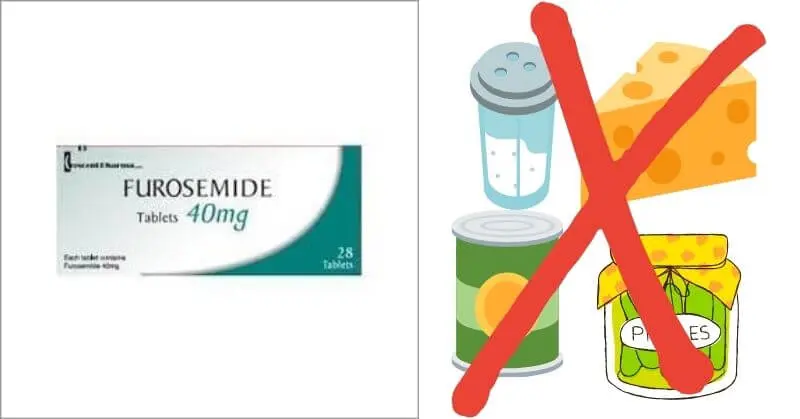Furosemide, also known by its brand name Lasix, is a loop diuretic medication commonly prescribed to treat fluid retention (edema) and high blood pressure. While it is effective in removing excess fluid from the body, it can also lead to the loss of essential nutrients, particularly potassium. To ensure the medication works effectively and to avoid potential side effects, it’s important to know what foods to avoid when taking furosemide. This article provides a detailed guide on which foods to limit or avoid, and why they matter for those on furosemide.
How Furosemide Works
Understanding how furosemide works is crucial to knowing what foods to avoid.
1. Furosemide as a Diuretic
Furosemide is a potent diuretic that works by increasing urine production, helping to eliminate excess fluid from the body. This process reduces blood pressure and alleviates fluid buildup in conditions like heart failure, liver disease, and kidney disorders.
2. Impact on Nutrient Levels
While furosemide effectively reduces fluid retention, it also causes the body to lose important minerals, such as potassium, sodium, magnesium, and calcium. An imbalance of these nutrients can lead to health issues, including muscle cramps, fatigue, irregular heartbeats, and other complications.
Foods to Avoid When Taking Furosemide
To ensure the effectiveness of furosemide and minimize side effects, certain foods should be avoided or limited. Here’s a list of foods to watch out for:
1. High-Sodium Foods
High-sodium foods can counteract the effects of furosemide by causing fluid retention and increasing blood pressure. Limiting sodium intake is essential for those taking this medication.
- Processed and Packaged Foods: Foods like canned soups, frozen meals, processed meats (such as bacon, sausages, and deli meats), and salty snacks are typically high in sodium.
- Restaurant and Fast Foods: Meals from restaurants and fast-food outlets often contain large amounts of sodium to enhance flavor and preserve freshness.
- Condiments and Sauces: Soy sauce, ketchup, salad dressings, and other condiments can be surprisingly high in sodium.
2. Licorice
Licorice, especially the black licorice candy and licorice root supplements, can interfere with potassium levels in the body, leading to further depletion when taking furosemide.
- Why to Avoid: Licorice contains glycyrrhizin, a compound that can reduce potassium levels, which is already a concern for those taking diuretics like furosemide.
- Alternatives: Opt for other types of sweets or herbal supplements that do not contain licorice or glycyrrhizin.
3. Alcohol
Alcohol can increase the diuretic effect of furosemide, leading to dehydration and further loss of essential minerals. It can also lower blood pressure, causing dizziness or fainting, especially when combined with furosemide.
- Moderation is Key: If you consume alcohol, do so in moderation and consult your healthcare provider for specific guidelines based on your condition.
- Choose Hydrating Alternatives: Instead of alcoholic beverages, opt for water, herbal teas, or non-caffeinated drinks to stay hydrated.
4. Potassium-Rich Foods (Under Medical Advice)
While potassium-rich foods are generally recommended for most people taking furosemide to counteract potassium loss, in certain cases, individuals may need to avoid or limit these foods due to underlying medical conditions.
- Common Potassium-Rich Foods: Bananas, oranges, spinach, tomatoes, potatoes, and avocados are all high in potassium.
- Consult Your Doctor: If you have a condition that requires potassium restriction (such as certain kidney diseases), consult your healthcare provider before making any dietary changes.
Foods to Limit When Taking Furosemide
While some foods should be avoided, others should be consumed in moderation. Here are foods you may want to limit:
1. High-Sugar Foods
Excessive sugar intake can contribute to weight gain, increase blood pressure, and negatively impact overall health, which may be counterproductive when managing conditions treated with furosemide.
- Limit Sugary Snacks: Reduce consumption of sugary treats like candies, cookies, pastries, and sugary beverages.
- Choose Natural Sweeteners: Consider using natural sweeteners like stevia or opting for whole fruits instead of processed sweets.
2. Caffeinated Beverages
Caffeine is a mild diuretic that can increase the effects of furosemide, potentially leading to dehydration and loss of minerals.
- Limit Coffee and Tea: Try to limit coffee, tea, and energy drinks, especially if you notice increased urination or symptoms of dehydration.
- Drink Water: Balance your intake of caffeinated beverages with plenty of water to stay hydrated.
Tips for Maintaining a Balanced Diet While Taking Furosemide
Maintaining a balanced diet is essential for managing your health while taking furosemide. Here are some helpful tips:
1. Focus on Fresh, Whole Foods
Choose fresh, whole foods that are naturally low in sodium and sugar.
- Include Fruits and Vegetables: Fresh fruits and vegetables are excellent choices for a balanced diet. Opt for a variety of colors and types to ensure you’re getting a wide range of nutrients.
- Lean Proteins: Incorporate lean protein sources such as chicken, fish, beans, and legumes, which are low in sodium and provide essential nutrients.
2. Stay Hydrated
Proper hydration is vital when taking diuretics like furosemide.
- Drink Water Regularly: Aim for at least 8 glasses of water a day, unless otherwise directed by your doctor. Hydration helps maintain electrolyte balance and supports overall health.
- Avoid Sugary and Caffeinated Drinks: Opt for water, herbal teas, or beverages without added sugars or caffeine.
3. Monitor Potassium Intake
Since furosemide can deplete potassium levels, it’s important to monitor your intake.
- Potassium-Rich Foods: If advised by your healthcare provider, include potassium-rich foods such as bananas, oranges, spinach, and tomatoes to help balance potassium levels.
- Use Supplements Wisely: Only take potassium supplements if prescribed by your doctor. Excessive potassium can be harmful, especially for those with kidney issues.
4. Consult Your Healthcare Provider
Always consult your healthcare provider or a registered dietitian before making significant changes to your diet, especially when taking medications like furosemide.
- Regular Check-Ups: Keep up with regular medical check-ups to monitor your health and adjust your diet and medication as needed.
Conclusion
Knowing what foods to avoid when taking furosemide is crucial for maximizing the effectiveness of the medication and minimizing potential side effects. Avoiding high-sodium foods, licorice, alcohol, and limiting certain foods like caffeine and sugar can help maintain a balanced diet and support your overall health. Always consult your healthcare provider for personalized advice tailored to your specific needs and condition.
Disclaimer: The content on Wellness Derive is for informational purposes only and not a substitute for professional medical advice, diagnosis, or treatment. Always consult a healthcare provider for medical concerns.



